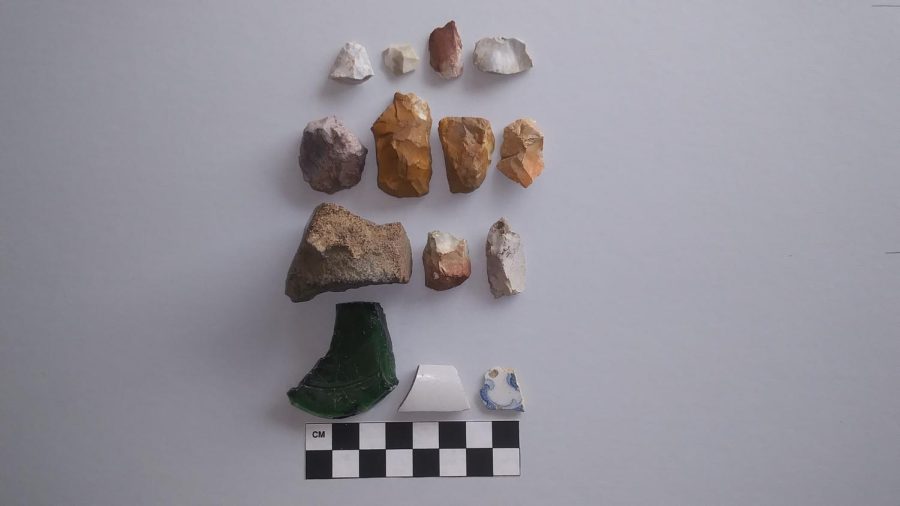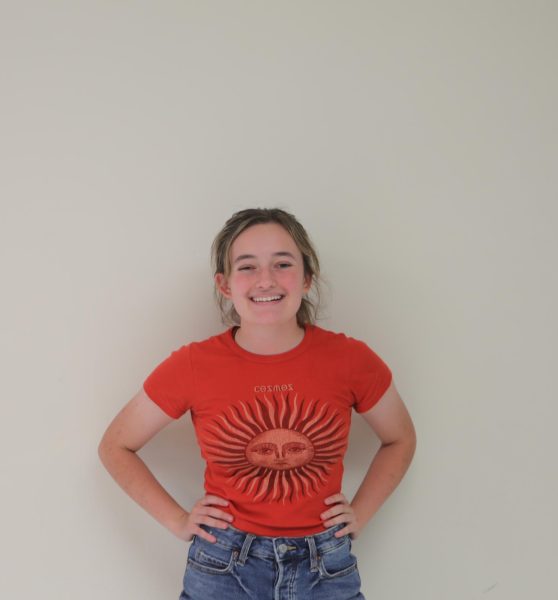Dig this: prehistoric site discovered
Artifacts found allude to Native American Community
Artifacts discovered at Willow Springs location, including a broken projectile point, a type of spearhead, utilized flakes, and other stone tool pieces (photo courtesy of Brian Bardy).
May 22, 2023
Located in the village of Willow Springs, an archeological site was found in the garden of a community restaurant in the spring of 2021. Since then, archeologist and LT para educator Brian Bardy has been working towards opening the site up for studying with the hopes of finding more artifacts to further investigate.
“Within the realm of cultural resource management, we have to be good stewards of the land,” Bardy said. “Any time we have the opportunity to do archeological investigations we should take on that responsibility because, as a rule, archaeological sites eventually get destroyed from development.”
The artifacts in question were unearthed during Willow Springs’ tilling season, in which gardens of the neighborhood had their soil broken up and prepared for planting, he said. These historic pieces have been coming to the surface due to disturbance of the ground, suggesting that there are more artifacts to be found beneath the surface that have been sitting in the village limits, predating known development. Some of the current relics that have been located include a broken projectile point, a tip of an arrowhead or spear, and other stone tools that show signs of being used for cutting.
“[What] we have found so far provides information on the types of [human] behaviors,” Bardy said. “For example, we [discovered] fire cracked rock, indicative of manmade fires produced for heat and cooking, most likely. There is also evidence for [the] capture and killing of animals, as well as the butchering and processing of hides.”
After coming across the known artifacts while passing the garden, LT staff member Terrance Quick immediately went to Bardy for his expertise. Bardy has been involved with many archeological digs, including taking part in LT’s very own land study in 2005 through past superintendent Dennis Kelly. While nothing of major historical significance was discovered on LT property, Quick and Bardy have high hopes that the new site will reveal much about the Willow Springs area.
“[Archeological digs] are worth pursuing because they tell us about the past, which we can use in the future,” Quick said. “We don’t learn anything unless we learn the past. [It is valuable] to learn from the historic tribes of our community, and it is interesting too.”
After getting permission from the property owner, Bardy and archeologist consultant Dan Melone plan to get started on preliminary investigations with shovel testing. If an intact site is discovered, Melone and Bardy will continue digging in late October when the ground is warm enough and the garden’s planting won’t be disturbed. From there, all new artifacts discovered will be cataloged, recorded, photographed, and reported to the Illinois Archaeological Survey (IAS) at the Illinois State Museum, Bardy said. The IAS is an organization that controls the database of all archaeological sites across the state, keeping the contents and information learned from excavations and digs open to the public. Once investigation and reporting are complete, the artifacts will be returned to the property owner.
“Archeology has come a long way,” Melone said. “It used to be just object collecting, but it has since focused on collecting knowledge. What was once a wealthy man’s game of finding beautiful things that would be put on display has shifted to a practice that values data which teaches us about the environment the people of the past have lived through. The objects that used to be discarded are now vital towards true understanding of history.”
There are numerous archeological sites that can be found in the Chicago land area because over the 13,000 years of prehistoric development, Native people lived everywhere and left a vital imprint, Melone said. However, just because a site is discovered does not guarantee the type of artifacts that may be found. Some prehistoric communities are extremely rare, such as the Paleo Indian sites because of their constant traveling and small numbers. As time went on, the population of camps increased and began to remain in one location. The more permanent a camp became, the larger the imprint it left on the land, but the less rare it is uncovered.
That being said, excavations today are not as common as they used to be because of how long, costly, and destructive they tend to be. Archeologists, like Melone, tend to favor fewer invasive methods of studying sites, such as shovel testing, use of magnetometers, and more. Currently, Melone and Bardy hope to shovel test the Willow Springs site this upcoming month, and proceed depending on what the site reveals.
“Come out with friends, with family, and check out the shovel testing in action,” Melone said. “[The] worst thing that can happen is that you get a little dirty. [Taking part in archeological studies] is a great way to learn something new and be a part of your community.”



















![Movie poster for '[Rec]" (2007).](https://www.lionnewspaper.com/wp-content/uploads/2023/04/rec-640x900.jpg)



